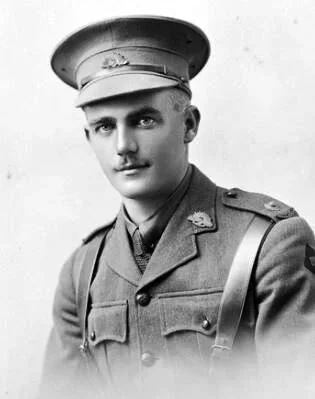Lieutenant Colonel Henry Normand MacLaurin
Born in Sydney 31 October 1878
Killed at Gallipoli 27 April 1915.
SUCC 1896-99
“...a man of lofty ideals ...”
MacLaurin is remembered at Gallipoli by a landmark called ‘MacLaurin’s Hill’.
He was a highly successful barrister, active in the militia forces when he enlisted on 15 August 1914, almost as soon as war was declared, and just over a week before his father died.
Tony Cunneen, who has done invaluable research into lawyers’ service in the Great War, has written about the NSW legal profession:
“While they were certainly members of what the historian Manning Clark called the “comfortable classes” they were also willing to forgo the security and safety of that class and give all their support to the cause of national identity and honour on the battle fields on the other side of the world.”
MacLaurin played only two seasons for Sydney University CC. In 1896-97, after scoring only 44 runs at 7.3 in 2nd Grade, he was inexplicably promoted to 1st Grade (1st Grade cap number 53) where he played another two games without distinction (15 runs at 7.5). In the season when the Club was readmitted on humbling terms to the 2nd Grade Competition in 1898-99, MacLaurin was twice selected in the1st XI (which won the 2nd Grade competition). An energetic 54 was followed by a non-descript 5 and he played no more.
A cousin was Ambrose Freeman (1873-1930) who played one 1st Grade game for SUCC in 1902 and whose brother, Douglas Freeman was killed at Quinns Post, Gallipoli, a week after MacLaurin was killed.
His mother was Eliza Ann (nee Nathan) (1846-1908) and his father was Sir Henry Normand MacLaurin (1835-1914), a Scotsman, Chancellor of the University of Sydney from 1896 until his death. He was also President of the Legislative Council, the Upper House of the NSW Parliament. A dominant figure in conservative politics, he was nevertheless admirably open to fresh educational ideas, especially those brought forward by the NSW Labor Government of 1910 which related to the reform of the Senate of the University. His second son, named after his father, was educated at Blair Lodge School Polmont in Scotland, a private boarding academy for boys, and then at Sydney Grammar School. Two other sons, Charles and Hugh both served in the War.
Charles was the father of Catherine who was in turn the mother of a prodigiously talented family including Alistair Mackerras, Headmaster of Sydney Grammar School from 1969 to 1989.
After graduation BA in 1899 and admission to the NSW Bar, MacLaurin carried on his work as a barrister from 11 Wentworth Chambers in Elizabeth St, specialising in accountancy. He also pursued a military career. Commissioned in the NSW Scottish Rifles in 1899, he eventually rose to command the 26th Infantry Regiment in July 1913. When he enlisted in the AIF, he was immediately appointed Lieutenant Colonel, commanding the 1st Infantry Brigade, a force of 4000 men. At 36 years of age, he was young for such responsibility but he wisely chose more experienced men to command battalions under him.
In a letter to Justice David Ferguson (whose son, Arthur, a Law student who had also been to Sydney Grammar, was killed in France in 1916) in March 1915, MacLaurin confided that rumours of the soldiers’ bad behaviour in Cairo had been exaggerated.
“With 20,000 men it can be easily seen that some would play up for a bit while their money lasted…”
He stood up for his men, attacking those civilians who were “doubtful and dissatisfied and critical”. Their accounts were “false and malicious”. Although he was a stern disciplinarian, he had a fine reputation among his men who respected his energy and enthusiasm especially when they trained under him in Egypt.
When orders of the landing at Gallipoli came through, MacLaurin was said to have “happily cancelled his leave and bounded smiling up the stairs to the General’s office to plan the attack.” (Cunneen).
During the afternoon of 27 April 1915, at about 3.15 pm, MacLaurin “was standing on the slopes of the ridge that now bears his name… in the act of warning soldiers to keep under cover when he too was shot dead…MacLaurin was buried by his men where he fell.” In 1919, he was reinterred at the 4th Battalion Parade Ground Cemetery. He was posthumously promoted to Brigadier General.
He was the fifth of the 337 from Sydney Grammar who were killed or who died in the War. An extraordinary 2172 ‘Old Sydneians’ enlisted. (I am indebted to Dr Philip Creagh who has carried out painstaking and forensic analysis of the Old Sydneians who enlisted). There was widespread grief among the legal profession. A ceremonial service to honour him was held at the Banco Court on 5 May 1915 and special mention was made in the minutes of the Bar Association.
He was the first of the Club’s former players to be killed.
CEW Bean, the Great War's pre-eminent historian, and the grandfather of Ted Le Couteur, a 1st Grader with the Club in the 1960s, wrote:
“…a man of lofty ideals, direct, determined, with a certain inherited Scottish dourness…but an educated man of action of the finest type that the Australian universities produce.”
James Rodgers





